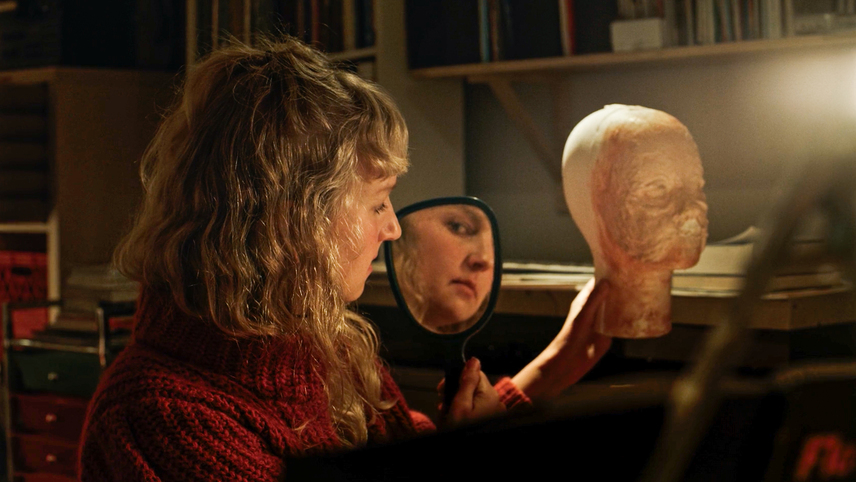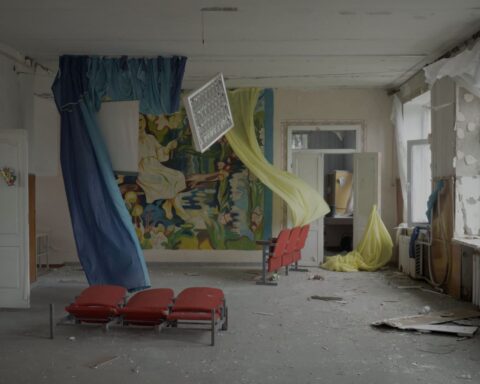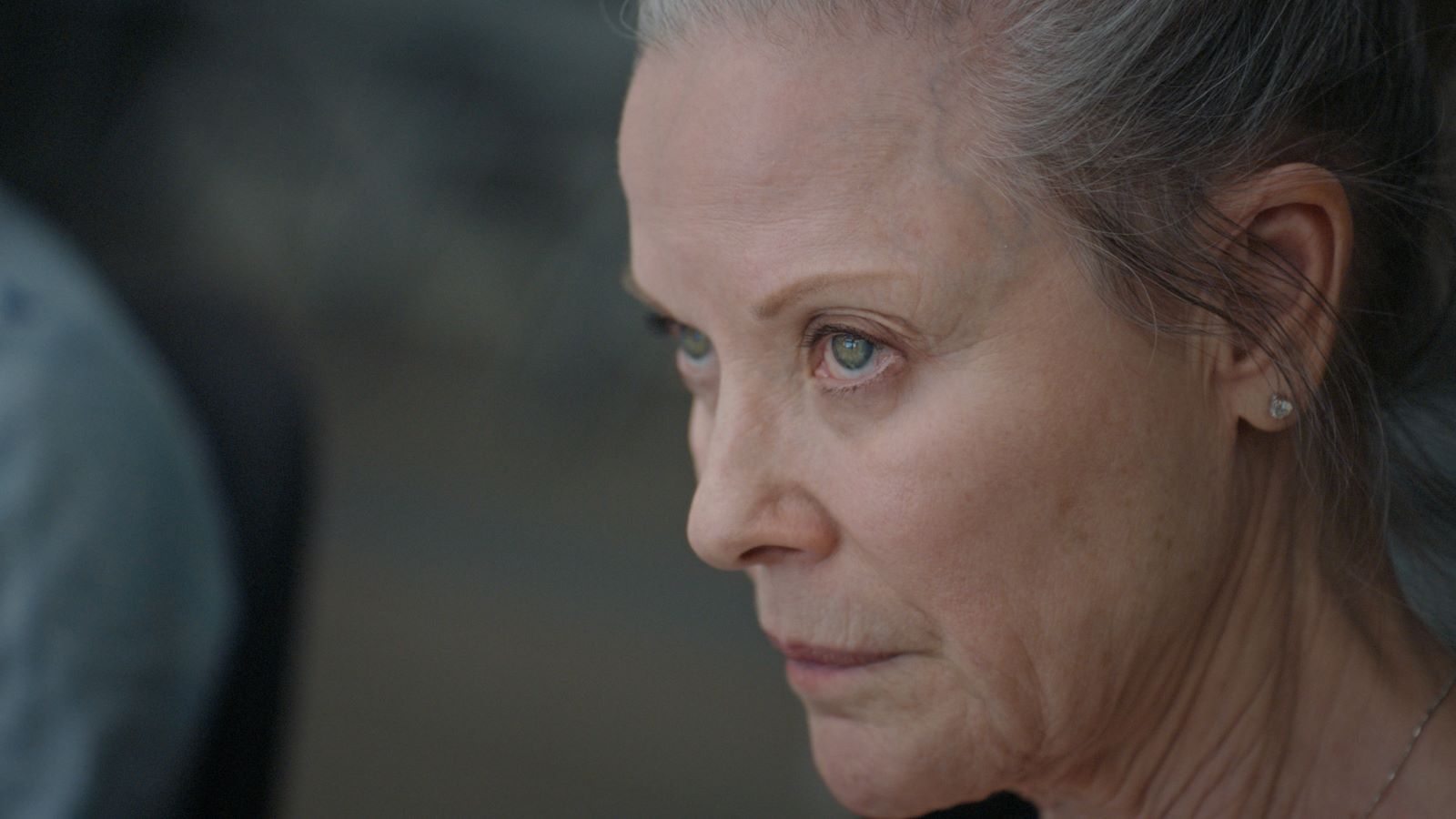With the Toronto International Film Festival in full swing this September, audiences can expect to find some of the most exciting new Canadian talents among the shorts programming. (Just check out films like Modern Goose, Aphasia, and Meteor, for example.) To mark the return of the Festival, MUBI is running some TIFF favourites, including Alice Diop’s award-winning Saint Omer and Véréna Paravel and Lucien Castaing-Taylor’s De Humani Corporis Fabrica. The series also boasts three must-see shorts: Untold Hours by Daniel Warth, It’s What Each Person Needs by Sophy Romvari, and I Thought the World of You by Kurt Walker. The films have little in common—one is a virtually silent observation of the artistic process, one an engaging study of phone-a-friend companionship, and the other an experimental consideration of an elusive one-hit wonder—but the three filmmakers share an interest in exploring the parameters of non-fiction storytelling. The next generation of Canadian talent is working with a new set of rules.
If anything united the trio recently during Zoom roundtable organized by MUBI, it’s their shared resistance to the term “documentary.” Each filmmaker conceptualizes his or her approach to non-fiction differently, opening up the form beyond Griersonian convention. For Warth, his is an “improvised film.” For Romvari, she and subject Becca Willow made a “collaborative observational fictional portrait.” And for Walker, his portrait of singer Lewis is a work of “speculative biography.”
Warth says that making the jump to non-fiction was a unique experience after directing dramas like the indie acting scene satire Dim the Flourescents, which won the Grand Jury Prize for Best Narrative Feature at Slamdance. Untold Hours shares Flourescents’ offbeat sense of portraiture. The film observes artist Alicia Nauta as she embarks in a unique project, photographing and sculpting her face into a creative reconstruction. “I was lucky that the subject and everything that happened with her was fairly contained, so it was easy for me to improvise a film,” explains Warth. The filmmaker likens the process of making Untold Hours to his fiction shoots: reacting to what’s happening in the moment with a small crew.

Warth says his free-flowing observation of Nauta as she sculpts the layers of her work had an additional challenge: her creative process means that each action happened only once. “We had to react to her actions and consider shots in the moment,” notes Warth. “I conceived the film as being very clear about what was going on from the beginning, but as I was realising there wasn’t going to be anything to hold the viewer’s hand in terms of narration or context, I had to use my writer brain and figure out at what point the audience will know what is going on.”
Nauta’s canvas gradually takes shape, and it’s a wonder to see the piece come together from an enigmatic blob. Warth says he found it exciting to let Nauta’s art reveal itself without spelling things out for the viewer. One simply watches along with the crew as the drama unfolds. “I let the form be driven by what I did and didn’t have access to, and by my improvised response to it,” notes Warth.
Romvari, meanwhile, uniquely captures her character’s story in It’s What Each Person Needs by eschewing fly-on-the-wall convention. The film rhythmically observes Willow in a call-and-response as she engages with two of her professional roles: she helps male callers get off and she offers innocent, platonic company for elderly women. She’ll tease one client to spank her in Niagara during one call, and tell another about her aspirations as a singer the next.
“There was a kind of negotiation with Becca around what we were doing, but we filmed it all over one weekend,” Romvari explains. “We just did it all in one go: she was doing the calls back to back, and we just filmed everything. The edit was a matter of finding the moments that were the most evocative and the ones that were most useful for juxtaposing the two modes of work that she does.” The contrast captures Willow’s work and the needs of her clients’ judgement-free. All the callers simply want the same thing: companionship.
The film marks something of a stylistic departure for Romvari after her short works that straddle fiction and non-fiction, in works like Pumpkin Movie, Norman Norman, and Still Processing. But to a knowing eye, It’s What Each Person Needs blurs the line for documentary by respecting Willow’s request that they not film in her home. Romvari says Willow found an Airbnb and worked with her to make a setting that felt right. “We tried to create a sense of home in that space that was visually more interesting,” says Romvari. “If you look at her Instagram, she takes photographs of herself in interesting spaces, so she has an online following for her own image and she has an eye of these eclectic, chaotic spaces.” The setting accentuates the sense of calm that Willow affords others, highlighting the need for connection, in any form, during the disjointed lockdown years.
Where Romvari’s film draws upon spoken conversations, Walker’s I Thought the World of You uses layers of music and text to explore the story of Calgary-based singer Lewis. Walker’s film asks the questions on music fans’ minds when Lewis’s 1983 album Amour sparked a cult following when someone picked it up at an Edmonton flea market in 2014. Lewis’s songs and mythology waft through the film as onscreen text features musings and comments on the online message board Hipinion.
“I was actually a part of that message board–it’s all contained in one thread, and there was some online sleuthing going on within this thread. It’s still ongoing,” says Walker. “I was playing with online messaging and the online experience in my previous work, and I carried that over into this film and wove the idea of the silent intertitle with online messages.” Other cards draw from the relatively limited interviews and news items about the singer. Dramatic interludes, still photos, and images of fans entranced by Lewis’s music further consider the aura that the singer casts from obscurity.
Navigating Creative Control
Where I Thought the World of You draws from the power of Lewis’s music, all three of the shorts boast engaging soundtracks that layer their stories with an active, sensory experience. Untold Hours, for example, features only a single line of dialogue, but remains a very sonic film as songs blur, creating a furious soundscape that mirrors Nauta’s tactile engagement with her art. Warth says that on one hand, this conceit is mostly practical. Since Nauta works alone, there naturally wouldn’t be any talking. Instead, the music that keeps her company acts as a narrative guide, noting the passage of time through songs. “The subject of my film insisted on listening to music while she worked, which of course makes it very difficult to edit into condensed days of work, so I didn’t have a way around it other than Foley,” notes Warth. “My approach was to have my eyes and ears open all the time and think about the cinematic possibilities of what I was getting.”
Imposing rules like avoiding dialogue offers a guide for the film, but also affords Untold Hours unique punctuation marks. For example, one scene follows Nauta as she shops at a thrift store. She tries on various garments, sometimes for comic effect. “There’s a moment early in the film where she holds up a small baby’s outfit in front of her body and chirpily says, ‘It’s too small,’” notes Warth. “I just couldn’t cut the line. It made me too happy.” With only three words, the film economically offers a sense of the character’s offbeat personality.
For Romvari’s film, It’s What Each Person Needs differs from her oeuvre since the personality at its centre isn’t the filmmaker herself, her dog, or a family member. “After making a lot of really vulnerable work, it was nice to do something that I had some distance from, and Becca was keen to collaborate,” observes Romvari. “It was a challenging experience because Becca had her own ideas about how she wanted to be depicted and I had my own ideas around performativity within documentary and wanted to highlight that within a portrait of someone who is trying to show a certain side of themselves.”
As filmmaker and participant navigate the biases they bring to the project, the film allows each side of the creative team to interrogate the choices entailed within making a portrait and relinquishing total control. Frequent close-ups of Becca’s hands, meanwhile, illustrate that no matter how much she embellishes her conversations with physicality, these aren’t mere empty gestures.

While Warth and Romvari harness the energy and routines of their characters as part of the narrative flow, Walker’s film explores the absence of its central figure, who retreated from public life (whatever sliver of it he had) years ago. “I felt like I was a P.I. for a good portion of developing this movie,” says Walker, adding that tackling Lewis’s story required deep dives during research. “I think I read every single word written about Lewis online and in print, and when it became clear that I wasn’t going to find him, I realised that I would have to do something more hybrid.”
But Walker admits that encountering closed doors or tracking down names of parties who refused to talk furthered the speculative approach he was considering. “I ended up embracing what I didn’t know and found a way to structure his absence, express his enigma, and tiptoe that line because enigma can easily tip into a vacuum,” says Walker. “It was also about embracing my own experience within this story as someone who was there in 2014 at the peak of the internet phenomenon around it.” Lewis ultimately becomes the key voice of the film as his signature song and mellow vocals engulf the soundtrack, paired with a long take of a fading sunset, letting viewers understand the emotional impact of his work on his online fans.
An Ecosystem for Creatives?
While these three films illustrate Canadian filmmakers finding creative new approaches to the art form in fiction and non-fiction alike, they’re also products of a film scene that doesn’t really know what to do with the next generation of auteurs. While opportunities like Telefilm Canada’s Talent to Watch do exist for first features, the stream generally favours narrative works. Exceptions to the rule exist, like Ryan Ermacora and Jessica Johnson’s Anyox, but they’re rare, especially for non-fiction, and the Canada Council is overburdened with applications for less commercial fare.
“I’ve reached a point where I want to make a feature film, and I’ve been trying to get it financed and developed for the last few years,” says Romvari. “It feels like there’s a missing piece in the finance system in Canada, for sure. I have made all these films and now I’m struggling really to find support to make a feature.” For Romvari, who has built a respectable body of shorts that have gained international attention, played international festivals, and even garnered a filmmaker spotlight on Criterion Channel (which is rare for Canadians in any format), the struggle illustrates how the industry isn’t meeting the appetite for creative growth.
“It used to be that you made a short, it’s a proof of concept, and then you make a feature,” adds Romvari. “Now you make 12 shorts and they all play festivals and get streaming, and then you can’t make a feature.”
“Or you make a feature and then it’s really hard to make another,” adds Warth. “Whatever benchmark there used to be, it doesn’t feel like it’s there. You can get a star or do something crazy, but even those things aren’t really any guarantee.”
Whether it’s a matter of changing the benchmarks, the funding streams, or the criteria, there’s more at stake when it comes to ensuring that filmmakers we celebrate as Canadian talent can realistically work here. “With funders and arts councils, there’s an opportunity to make your first feature, and then there isn’t beyond that unless you become the exception to the rule,” observes Walker. “That’s a major issue that isn’t discussed enough. A common conversation with peers is about filmmakers looking to the U.S. and going to the U.S., and that’s exactly what [funders] don’t want, but that’s what these funding bodies are manifesting.” There’s no shortage of talent in Canada, as the MUBI spotlight shows, but every generation needs room for growth.













